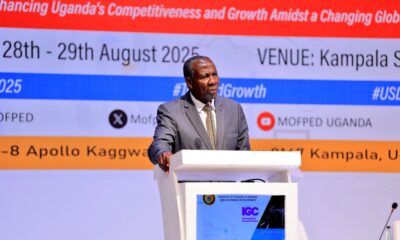Economy
Uganda’s Economy Grows to Shs 226 Trillion as Government Sets Sights on $500 Billion Target
Uganda’s economy has maintained strong resilience and posted steady growth despite global and regional shocks, according to the Minister of Finance, Planning and Economic Development, Hon. Matia Kasaija.
Presenting the State of the Economy at the Ministry headquarters in Kampala on Tuesday, Kasaija revealed that the economy expanded to Shs 226.3 trillion (USD 61.3 billion) in the financial year 2024/25, up from Shs 203.7 trillion (USD 53.9 billion) the previous year. This represents a 6.3 per cent growth rate, slightly higher than the 6.1 per cent recorded in FY 2023/24. GDP per capita also rose to USD 1,263, from USD 1,159.
“Uganda’s economy remains robust, supported by stable inflation, a stronger shilling, increased investor confidence, and growing private sector activity,” Kasaija said. “We are on course to transform our economy to USD 500 billion in the next 15 years under the Ten-Fold Growth Strategy.”
Kasaija attributed the growth to government-backed wealth creation programs such as the Parish Development Model (PDM), Emyooga, Uganda Development Bank (UDB) financing, the Agricultural Credit Facility, and the Small Business Recovery Fund, alongside stable fiscal and monetary policies.
Inflation was reported at 3.8 per cent in July 2025, down from 3.9 per cent in June, mainly due to reduced food prices and falling fuel costs. The Central Bank Rate has been held at 9.75 per cent for ten consecutive months to balance inflation control with economic expansion.
The Uganda shilling appreciated by 0.5 per cent in July 2025, averaging Shs 3,586 per US dollar, buoyed by foreign exchange inflows from investors, remittances, and rising coffee export receipts. The IMF recently ranked the shilling the most stable currency in Africa.
Private sector credit also grew by 7.5 per cent over the year, reaching Shs 23.9 trillion by June 2025, reflecting increased lending and business activity.
Exports, Tourism, and FDI Rising
Uganda’s exports have diversified significantly, with 32 new manufactured products entering the international market over the past 15 years. Coffee’s dominance in export earnings has fallen from 75.6 per cent in 1995 to 20.9 per cent, making way for gold (39.3%), cocoa (5.8%), metals (2.1%), and sugar (1.9%).
Merchandise exports jumped by 64.3 per cent in the year to June 2025, reaching USD 1.15 billion, while imports rose by 50.7 per cent to USD 1.43 billion.
The tourism sector also recorded growth, with earnings climbing to USD 1.52 billion by March 2025, compared to USD 1.36 billion in the same period of 2024. Uganda also registered USD 3.3 billion in Foreign Direct Investment (FDI) inflows in 2024, largely driven by the oil and gas sector.
Revenue and Social Indicators Improve
Domestic revenue collection surpassed projections, hitting Shs 32.08 trillion against a target of Shs 31.98 trillion in FY 2024/25. In July 2025 alone, revenues and grants amounted to Shs 2.54 trillion, exceeding the Shs 2.46 trillion target.
On the social front, Uganda’s progress was highlighted in the Human Development Report 2025, where the country’s Human Development Index improved from 0.550 in 2022 to 0.582 in 2023, moving Uganda up to 157th position globally. Life expectancy has risen from 63.7 to 68.9 years, while poverty levels dropped from 20.3 per cent in 2020 to 16.1 per cent in 2024.
Kasaija projected a stronger growth of 7 per cent in FY 2025/26, with expectations of double-digit growth in the medium term once oil and gas production commences.
“The Ten-Fold Growth Strategy will focus on agro-industrialisation, tourism, mineral-based industries, and innovation in science and ICT,” he said. “This is the path that will transform Uganda into a middle-income economy and beyond.”
Comments



























